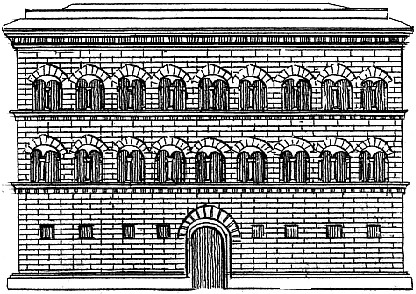Giovanni (Zuane) di Antonio Buora of Osteno
sculptor and architect.
Buora appears frequently in the Venetian records, especially in association with Pietro Lombardo, in the construction of the Scuola di S. Marco in Venice, in 1489 and 1490. He made the doorway of the church of S. Zacearía, Venice. In 1494 he began the dormitorio of the monastery of S. Giorgio Maggiore, Venice.
Martin Chambiges (Sambiches, Cambiches)
architect (Maître Maçon); d. August 29, 1532.
Martin Chambiges was called from Paris to Sens (Yonne, France) in 1489, to design the new transept of the cathedral. He began the construction November 8, 1490, and in 1494 transferred the superintendence to Hugues Cavelier, afterward making occasional visits of inspection. He appears to have modified his plans in 1498. November 7, 1499, Martin was invited to attend consultations in Paris concerning the reconstruction of the Pont Notre Dame, which had fallen during the preceding month. In 1501 he commenced the doorway called Portail d'Abraham; and in 1513 the northern portal of the cathedral of Sens. In 1502 Martin was invited to Troyes (Aube, France), to advise concerning the construction of the facade of the cathedral (see Bailly, Jean, (I)). He designed the facade with its two towers and portal in 1502-1503, but did not commence building until the autumn of 1506. In 1500 he made the plans for the transept of the cathedral of Beauvais (Oise, France). He began construction at once, and continued in charge until his death. He was assisted by Jean Wast (I). Martin Chambiges was thus concerned in building three of the most beautiful cathedrals of France.
Il Cronaca (Simone del Pollajuolo)
Florentine architect; b. October 30, 1457; d. 1508.
Simone was called Cronaca, the chronicler, from his endless stories about the Roman monuments. He was brought up as a woodworker, intarsiatore, spent much time in Rome, and acquired a thorough knowledge of the antiquities. The buildings which can with certainty be credited to him are in Florence and not very numerous. In 1489 he superintended work upon the roofs of the Duomo. In 1490 he was appointed maestro dei scarpellini at the Palazzo Strozzi, and in 1497 became architect of that building. Cronaca substituted plain stone for rustication in the last three courses, and designed the celebrated cornice of the Strozzi. At about this time he built the sacristy of Santo Spirito from the model by Giuliano da San Gallo. The fine church of S. Salvatore al Monte (consecrated 1504) is attributed to Simone by Vasari. It was much admired by Michelangelo. June 23, 1495, Cronaca was made capomaestro of the Duomo, and after July 15, 1495, built the great hall of the Palazzo Vecchio, entirely remodeled by Vasari. Milanesi publishes a Prospetto Cronologico della vita e delle opere di Cronaca in his Vasari.
Gil de Silve
architect and sculptor.
Originally from Burgos (Spain). Gil is known by the fine tombs of King Juan II and the Infante Don Alonso, which were placed in the presbytery of the Chartreuse of Miraflores (Spain) by Queen Isabella. They were begun in 1489 and finished in 1493, and are among the latest and finest of the Gothic monuments of Spain.
Peter Vischer
sculptor and bronze founder; b. probably between 1460 and 1470; d. 1487.
A son of Hermann Vischer; he received the title Meister in 1489, and was probably twenty-five or thirty-five years old at that time. He was intimately associated with Adam Kraft and the bronze worker Sebastian Lindenast. His five sons, Hermann, Peter, Hans, Paul, and Jakob, assisted him in his work. The elder sons, Hermann and Peter, were most skillful. From their atelier came the statues of Otto IV, Henneberg in the Stiftskirche of Römhild, the monuments of the bishops Heinrich III, Veit II, and Georg II in the cathedral of Bamberg (Bavaria), five monuments in the Fürstenkapelle at Meissen (Saxony), the monument of the bishop Johann IV in the cathedral of Breslau (about 1496), the monument of the Cardinal Friedrich in the cathedral of Krakau (Poland), the monument of Archbishop Ernst in the cathedral of Magdeburg (about 1497), etc. Peter Vischer's most important work is the great shrine of S. Sebaldus in the church of S. Sabeldus in Nürnberg (1508-1519). The first sketches of this work were made by Veit Stoss.
| |

Façade of the Palace Strozzi at Florence, commenced from the designs of Benedetto de Maiano, brother of Giuliano de Maiano, and terminated by Cronaca, who designed the cornice.
Seroux
| |
|